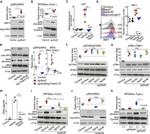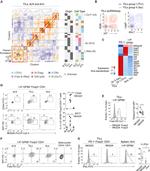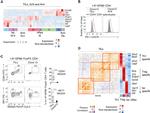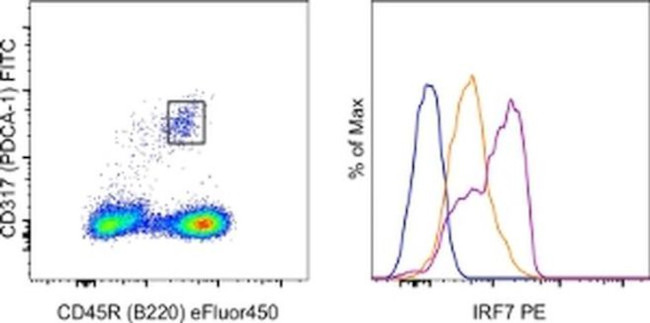Search Thermo Fisher Scientific
图: 1 / 4
IRF7 Antibody (12-5829-82) in Flow




产品信息
12-5829-82
种属反应
已发表种属
宿主/亚型
分类
类型
克隆号
偶联物
激发/发射光谱
形式
浓度
纯化类型
保存液
内含物
保存条件
运输条件
RRID
产品详细信息
Description: The monoclonal antibody MNGPKL reacts with mouse interferon regulatory factor 7 (IRF7), a 54 kDa transcription factor essential for induction of the antiviral innate immune response and IFN alpha production. B cells, plasmacytoid dendritic cells (pDC), and monocytes constitutively express IRF7 in the cytoplasm until activation by viral infection, double-stranded RNA or Toll-like receptor (TLR) signaling. CpG ODNs and single-stranded RNA, recognized by CD289 (TLR9) and TLR7, respectively, trigger IRF7 activation and upregulation. This activation promotes type I IFN response to disrupt pathogen and viral infection. These events causeIRF7 phosphorylation and translocation to the nucleus where it forms a homodimer to affect transcription.
Applications Reported: This MNGPKL antibody has been reported for use in intracellular staining followed by flow cytometric analysis.
Applications Tested: This MNGPKL antibody has been tested by intracellular staining and flow cytometric analysis of stimulated mouse splenocytes using the Intracellular Fixation & Permeabilization Buffer Set (Product # 88-8824-00) and protocol. Please refer to Best Protocols: Protocol A: Two step protocol for (cytoplasmic) intracellular proteins located under the Resources Tab online. This can be used at less than or equal to 0.25 µg per test. A test is defined as the amount (µg) of antibody that will stain a cell sample in a final volume of 100 µL. Cell number should be determined empirically but can range from 10^5 to 10^8 cells/test. It is recommended that the antibody be carefully titrated for optimal performance in the assay of interest.
Excitation: 488-561 nm; Emission: 578 nm; Laser: Blue Laser, Green Laser, Yellow-Green Laser.
Filtration: 0.2 µm post-manufacturing filtered.
靶标信息
Interferons (IFNs) are involved in a multitude of immune interactions during viral infections and play a major role in both the induction and regulation of innate and adaptive antiviral mechanisms. During infection, host-virus interactions signal downstream molecules such as transcription factors such as IFN regulatory factor-3 (IRF3) which can act to stimulate transcription of IFN-a/b genes. IRF7 has been shown to play a role in the transcriptional activation of virus-inducible cellular genes, including interferon beta chain genes. IRF7 play a major role in the innate immune pathway, interacting with the Toll-like receptor (TLR) adaptor proteins MyD88 and Tirp/TRAM and functioning as an intermediate TLR4 and TLR9 signaling. There are at least four differentially spliced isoforms of IRF7, although their function has not been clearly established.
仅用于科研。不用于诊断过程。未经明确授权不得转售。
How to use the Panel Builder
Watch the video to learn how to use the Invitrogen Flow Cytometry Panel Builder to build your next flow cytometry panel in 5 easy steps.
生物信息学
蛋白别名: Interferon regulatory factor 7; IRF-7
基因别名: Irf7
UniProt ID: (Mouse) P70434
Entrez Gene ID: (Mouse) 54123




